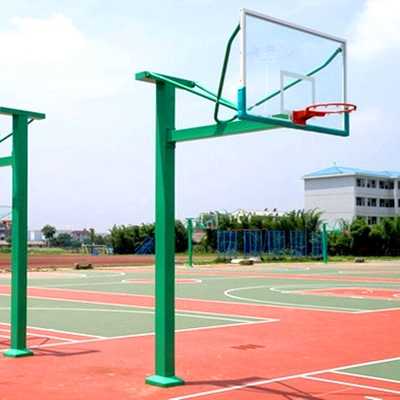What is the appropriate arm span for an in-ground basketball hoop?
The choice of arm span (the horizontal distance from the upright to the rim) for in-ground basketball hoops requires comprehensive consideration of factors such as usage scenario, available space, safety requirements, and budget. Common suitable arm span lengths range from 1.8 meters to 2.25 meters. A detailed analysis follows:

I. Common Arm Span Specifications and Applicable Scenarios
1.8-meter Arm Span
Applicable Scenarios:
Standard school courts: Meets the requirements of the "Standards for the Provision of Sports Equipment and Facilities in Primary and Secondary Schools," suitable for daily teaching, training, and small-scale competitions.
Site with limited space: Prioritized when saving lateral space, such as rooftop courts, elevated floors, or multi-functional courts.
Advantages: Lower cost, flexible installation, suitable for schools with limited budgets or space constraints.
Case Study: A primary school, due to insufficient court width, chose 1.8-meter arm span basketball hoops and successfully installed two sets of equipment within the limited space.
2.25-meter Arm Span
Applicable Scenarios:
Formal competition venues: Meets FIBA standards, suitable for school-level, city-level, and above basketball competitions.
High-intensity use venues: Such as training fields for athletes with special talents or professional basketball courts, which need to meet the demands of frequent shooting and dunking.
Advantages: Provides a more standard shooting angle and space, reduces the risk of the basketball flying off the court, and enhances the game experience.
Case Study: A key middle school upgraded its basketball hoops to 2.25-meter arm spans to host a city-level competition, which was approved by the organizing committee.
II. Core Considerations for Choosing Arm Span
Field Space
Lateral Space: The longer the arm span of the basketball hoop, the wider the required field. For example, the distance between two 2.25-meter arm span basketball hoops needs to be ≥6 meters (including the safety buffer zone), while a 1.8-meter arm span can be reduced to 5 meters.
Vertical Space: With the bottom edge of the backboard 2.9 meters from the ground and the rim height 3.05 meters, it is necessary to ensure that the field is free of low obstacles (such as walls or trees).
Target Users
Elementary School Students: Due to their shorter stature, a 1.8-meter arm span can meet basic shooting needs and is safer (reducing the risk of climbing).
For middle school students/adults: A 2.25-meter wingspan better conforms to standard shooting motion, avoiding shooting form distortion caused by a shorter wingspan.
Safety Requirements: Collision-resistant design: The longer the wingspan, the lower the risk of the basketball flying off the court, but sufficient safety buffer zones must be ensured around the court (≥2 meters outside the end line, ≥1 meter outside the sideline).
Structural stability: Longer wingspans require higher strength for embedded parts and uprights, necessitating the selection of thicker steel (e.g., □150×150×5mm square tubing) and a deeper embedding design (≥1.2 meters).
Budget Costs: Equipment price: Due to the increased material usage and manufacturing complexity, 2.25-meter wingspan basketball hoops are typically 20%-30% more expensive than 1.8-meter models.
Installation costs: Longer wingspans require more precise court measurements and embedded part positioning, potentially increasing labor costs by 10%-15%.
III. Recommendations for Special Scenarios
Multifunctional Venues
Requirements: If the venue needs to accommodate activities such as volleyball and badminton, an adjustable-arm-length basketball hoop (with arm length adjusted hydraulically or electrically) can be selected, but its stability is slightly lower than that of a fixed hoop.
Case Study: A school uses adjustable-arm-length basketball hoops for basketball training during the day and as a volleyball court at night after adjusting the arm length.
Roof or Elevated Floor Installation
Problem: Roof load-bearing capacity is limited, and the total weight needs to be controlled.
Solution: Choose a lightweight basketball hoop made of aluminum alloy (40% lighter than steel), or shorten the arm length to 1.5 meters (it needs to be confirmed whether this will affect the user experience).
Use by Students with Disabilities
Requirements: According to the "Accessibility Design Code," a low-profile basketball hoop (2.6 meters high) can be installed for wheelchair basketball players, and the arm length can be shortened to 1.2 meters to adapt to venue limitations.
padel court,Gymnastic mats, basketball racks, volleyball posts, tennis dwellings, badminton posts, adult gymnastic equipment, parallel bars, horizontal bars, uneven bars, gymnastic rings, balance beams, saddles, hydraulic referee tables, table tennis tables, outdoor fitness equipment, garden fitness equipment
Website:
http://hransports.com/article/333.html